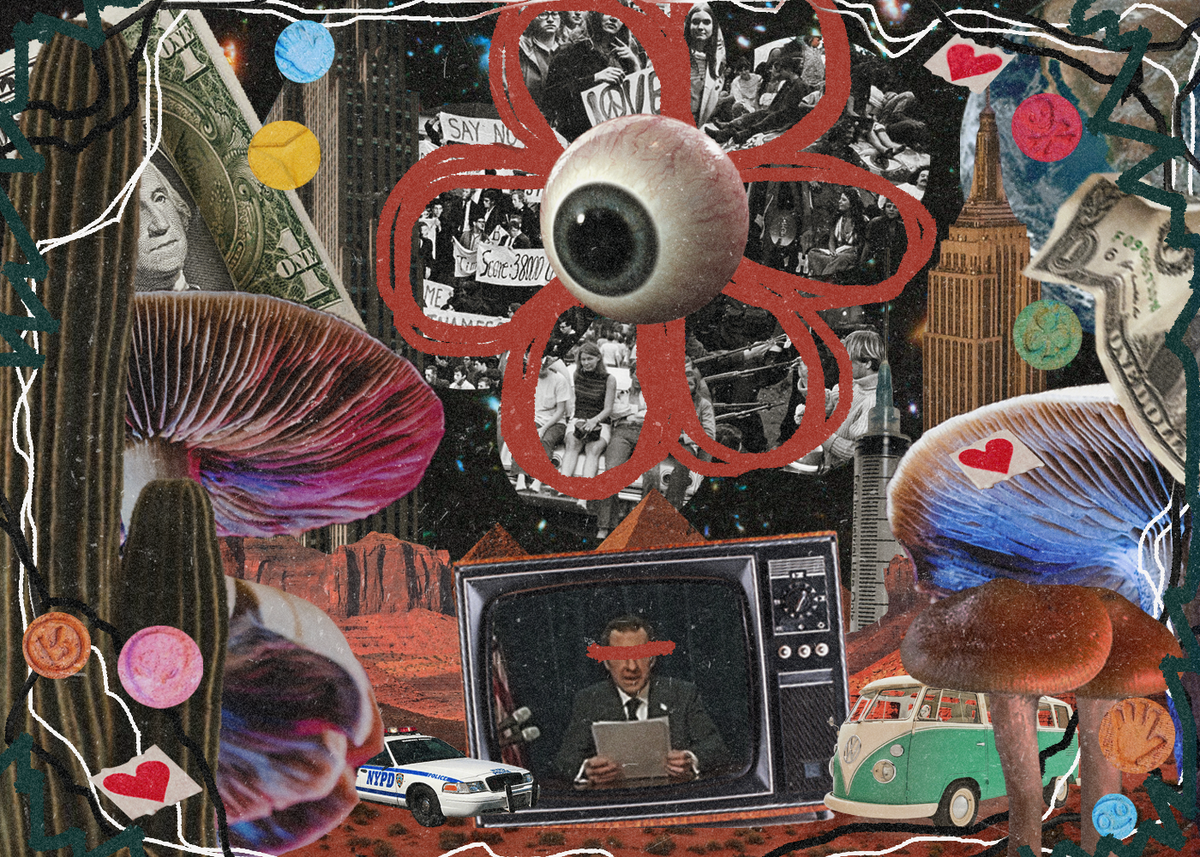With our current lack of understanding of psychopharmacological medications, ground-breaking therapies are long overdue. It is up to legislative frameworks to liberate psychedelics, amongst other classed substances, to reform mental health systems. By Anushka Barthwal.
The popularisation of psychedelic drugs sprung across the United States, particularly amongst youth activist groups of the 1960s. They created what became known as the “counterculture' or “hippie” movement, which likely posed a threat to US President Richard Nixon’s administration at the time. The hard-line ban on psychedelics is thus thought to have been politically motivated because left-wing ideals became increasingly and conveniently discredited based on their associations to reckless drug abuse and socially disruptive behaviours.
The research barriers and social stigma surrounding psychedelics became formally grounded in the 1971 Controlled Substance Act (CSA) established by Nixon as a means to curb the crisis. This legislative approach was rapidly adopted by countries across the world. Psychedelics have since been classed Schedule I, which the CSA deems as substances with:
a) high potential for abuse
b) no accepted medical use in treatment in the United States
c) a lack of accepted safety for its use under medical supervision [1]
Nixon’s successors carried forward with more force and shifted the focus from a treatment centred approach to an all-out criminal crack-down. This strategy has only led to more public health concerns; cutting supply rather than implementing ways to limit demand means that addicts seek alternative and consequently, more dangerous ways to fuel their addiction. The collateral social marginalisation and stigmatisation of drug users generated a short-lived drop in drug use, but a longstanding global surge of large-scale human rights violation, corruption, disease epidemics, violence and mass incarcerations [2].
Legal bodies have since established the perception of psychedelics that persists to this day; one that is steeped in misinformation, politicisation, and fear. But, how appropriate is this stance, and how successful is the legislation it informs?
While there is a moderate abuse potential to psychedelics, the lack of medical applications and perceived danger of such treatments is simply inaccurate. A 2016 study conducted by researchers at John Hopkins University provides evidence of its successful medical applications through extensive clinical safety protocols. The randomised double-blind trial investigated the significance of Psilocybin, the psychoactive compound found in what is referred to as “magic mushrooms,” for the palliative treatment of psychologically distressed, terminal cancer patients. The results showed substantial decreases in end-of-life anxiety and depression, and marginal increases in optimism, acceptance, and quality of life, as reported by both clinician and self-rated measures. 6-month follow-ups with the participants showed that these improvements were sustained as ~80% continued to present clinically significant decreases in depressed and anxious moods. Considering that up to 40% of cancer patients meet criteria for a mood disorder – most likely associated with prolonged hospitalisation, poor treatment adherence, decreased quality of life and suicidality – this could make for significantly impactful palliative treatment for end-stage patients [3].
More recently, the Multidisciplinary Association for Psychedelic Studies (MAPS) has worked extensively to assist scientists in designing, funding and obtaining regulatory approvals for the safe and effective study of several controlled substances. 3,4-Methylenedioxymethamphetamine (MDMA), colloquially referred to as “Ecstasy” or “Molly”, is a synthetic stimulant drug with psychoactive properties that has shown to regulate levels of anxiety and depression. In 2021, MAPS published their reports on the clinical significance of MDMA-assisted therapy in the treatment of posttraumatic stress disorder (PTSD). Alongside extensive safety records, 88% of participants with a clinically meaningful reduction in symptoms and 67% of participants no longer qualified for a PTSD diagnosis [4]. Compared to the current first line treatment for PTSD i.e. selective serotonin reuptake inhibitor drugs with a 35% remission rate, this is most definitely a breakthrough therapy that should follow through [5].
While the CSA doesn’t necessarily ban the research of Schedule I substances, the legislative and financial constraints involved in its investigation heavily discourage prospective researchers and sponsors. Fortunately, governing bodies are beginning to move towards revising their legal frameworks to promote research on the potential therapeutic benefits of these substances, taking us towards the “Psychedelic Renaissance”.
Through the course of time, multiple factors have influenced our arrival at the current legislative climate for psychedelic substances. If there is anything we can take away from the aftermath of the 60s, it is to support and take an educative stance towards the safe and regulated use of controlled substances for therapeutic use. Further, it is imperative we put those suffering from substance-use disorders in the hands of public health services rather than police forces. The history of psychedelics has shed light on the importance of integrating scientific grounds with mass media, legislation, political and public health initiatives and the harsh realities of trivialising them.
References
[1] The controlled substances act [Internet]. DEA. [cited 2022Dec5]. Available from: https://www.dea.gov/drug-information/csa
[2] Research guides and class pages: The War on Drugs: History, policy, and therapeutics: History of the War on Drugs [Internet]. History of the War on Drugs - The War on Drugs: History, Policy, and Therapeutics - Research Guides and Class Pages at Dominican University. [cited 2022Dec5]. Available from: https://research.dom.edu/the-war-on-drugs--history-policy-therapeutics/history#s-lg-box-27353561
[3] Griffiths RR, Johnson MW, Carducci MA, Umbricht A, Richards WA, Richards BD, et al. Psilocybin produces substantial and sustained decreases in depression and anxiety in patients with life-threatening cancer: A randomized double-blind trial [Internet]. Journal of psychopharmacology (Oxford, England). U.S. National Library of Medicine; 2016 [cited 2022Dec5]. Available from: https://www.ncbi.nlm.nih.gov/pmc/articles/PMC5367557/
[4] Mitchell JM, Bogenschutz M, Lilienstein A, Harrison C, Kleiman S, Parker-Guilbert K, et al. MDMA-Assisted therapy for severe PTSD: A randomized, double-blind, placebo-controlled phase 3 study [Internet]. Nature News. Nature Publishing Group; 2021 [cited 2022Dec5]. Available from: https://www.nature.com/articles/s41591-021-01336-3
[5] Thase ME, Entsuah AR, Rudolph RL. Remission rates during treatment with venlafaxine or selective serotonin reuptake inhibitors: The British Journal of Psychiatry [Internet]. Cambridge Core. Cambridge University Press; 2018 [cited 2022Dec5]. Available from: https://www.cambridge.org/core/journals/the-british-journal-of-psychiatry/article/remission-rates-during-treatment-with-venlafaxine-or-selective-serotonin-reuptake-inhibitors/9AAF0C7C31BDC9099634EB6E5FACB178





